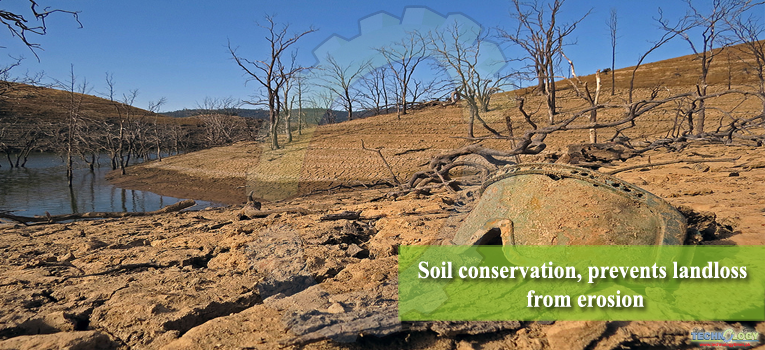Soil conservation is the prevention of landloss from Erosion or prevention of reduced fertility caused by over usage salinization, acidification, or other chemical soil contamination.

Method of soil conservation
- Contour planting
- Terracing farming
- keyline design
- Runoff control
- Windbreak
- Cover crop
- Crop rotation
- Soil conservation farming
- salinity Management
- Soil Organism
- Mineralization
- Contour Ploughing
Orients furrows following the contour lines of the farmed area. Furrows move left and right to maintain a constant altitude, which reduces runoff. Contour ploughing was practiced by the ancient Phoenicians, and is effective for slopes between two and ten percent. Contour ploughing can increase crop yields from 10 to 50 percent, partially as a result of greater soil retention.
- Terrace Farming
The practice of creating nearly level areas in a hillside area. The terraces form a series of steps, each at a higher level than the previous. Terraces are protected from erosion by other soil barriers. Terraced farming is more common on small farms and in underdeveloped countries, since mechanized equipment is difficult to deploy in this setting.
- Keyline design
Is an enhancement of contour farming, where the total watershed properties are taken into account in forming the contour lines.
- Perimeter runoff control
Tree, shrubs and ground-cover are effective perimeter treatment for soil erosion prevention, by impeding surface flows. A special form of this perimeter or inter-row treatment is the use of a “grass way” that both channels and dissipates runoff through surface friction, impeding surface runoff and encouraging infiltration of the slowed surface water.
- Windbreaks
Windbreaks are sufficiently dense rows of trees at windward exposure of an agricultural field subject to wind erosion Evergreen species provide year-round protection; however, as long as foliage is present in the seasons of bare Soil surfaces, the effect of deciduous trees may be adequate.
- Cover crops/crop rotation
Cover crops such as legumes plant, white turnip, radishes and other species are rotated with cash crops to blanket the soil year-round and act as green manure that replenishes nitrogen and other critical nutrients. Cover crops also help suppress weeds.
- Soil-conservation farming
Soil-conservation farming involves no-till farming, “green manures” and other soil-enhancing practices. Such farming methods attempt to mimic the biology of barren lands. They can revive damaged soil, minimize erosion, encourage plant growth, eliminate the use of nitrogen fertilizer or fungicide, produce above-average yields and protect crops during droughts or flooding.
The result is less labor and lower costs that increase farmers’ profits. No-till farming and cover crops act as sinks for nitrogen and other nutrients. This increases the amount of soil organic matter.
Repeated plowing/tilling degrades soil, killing its beneficial fungi and earthworms. Once damaged, soil may take multiple seasons to fully recover, even in optimal circumstances.
Critics argue that no-till and related methods are impractical and too expensive for many growers, partly because it requires new equipment. They cite advantages for conventional tilling depending on the geography, crops and soil conditions. Some farmers claimed that no-till complicates weed control, delays planting and that post-harvest residues, especially for corn, are hard to manage.
- Salinity management
Salinity in soil is caused by irrigating with salty water. Water then evaporates from the soil leaving the salt behind. Salt breaks down the soil structure, causing infertility and reduced growth.
The ions responsible for salination are: Sodium (Na+), Potassium (K+), Calcium (Ca2+), Magnesium (Mg2+) and Chlorine (Cl-). Salinity is estimated to affect about one third of the earth’s arable land. Soil salinity adversely affects crop Metabolism and erosion usually follows.
Salinity occurs on drylands from over irrigation and in areas with shallow saline water tables. Over-irrigation deposits salts in upper soil layers as a byproduct of soil infiltration; irrigation merely increases the rate of salt deposition.
Use of humic acids may prevent excess salination, especially given excessive irrigation Humic acids can fix both anions and cations and eliminate them from root zones
Planting species that can tolerate saline conditions can be used to lower water tables and thus reduce the rate of capillary and evaporative enrichment of surface salts.
- Soil Organisms
When worms excrete egesta in the form of casts, a balanced selection of minerals and plant nutrients is made into a form accessible for root uptake. Earthworm casts are five times richer in available Nitrogen, seven times richer in available Phosphates and eleven times richer in available Potash than the surrounding upper 150 milli metres (5.9 in) of soil.
The weight of casts produced may be greater than 4.5 kg per worm per year. By burrowing, the earthworm improves soil porosity, creating channels that enhance the processes of aeration and drainage.
Other important soil organisms include nematodes, mycorrizha and bacteria. Degraded soil requires synthetic fertilizer to produce high yields. Lacking structure increases erosion and carries nitrogen and other pollutants into rivers and streams.
- Mineralization
To allow plants full realization of their phytonutrient potential, active Mineralization of the soil is sometimes undertaken. This can involve adding crushed rock or chemical soil supplements.
In either case the purpose is to combat mineral depletion. A broad range of minerals can be used, including common substances such as Phosphorus and more exotic substances such as Zinc and Selenium.